
A few years back when I was
researching my Scottish Families, I ran into a literal "dead end". I
located my family but the next generation was a mystery until a very good friend
& mentor of mine, Jim Nesbitt (aka "Swift Otter") told me about Scottish Naming
Patterns. Now, this isn't carved in stone, but for me, it was worth
checking out as my family in question did follow the old naming pattern and it
helped me fill in the missing pieces.
I'm including various
nationalities here and if you have additional ones not mentioned, email me and
we'll add them.
| |
|
The first son is named after the mother's father.
mother's father.
The second son is named after the father's father.
The third son is named after the father.
The first daughter is named after the father's mother.
The second daughter is named after the mother's mother.
The third daughter is named after the mother.
|
Until the Counter-Reformation in the 16th
century, both saints' names and pagan names were used. At the time of the
Counter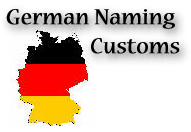 -Reformation,
pagan names were abandoned and the Lutherans
began to use only the names of saints found in the Bible or Old Testament
names. Also, the number of names given to an
infant has varied from century to century. -Reformation,
pagan names were abandoned and the Lutherans
began to use only the names of saints found in the Bible or Old Testament
names. Also, the number of names given to an
infant has varied from century to century.
The custom of adding a secular name to the
Christian name began in the 1500s, giving the child two first names: for
example, Johann Georg and Anna Margaretha. To further complicate matters,
in the 1600s children were also given two baptismal names. In the later
part of the 1700s, single names were again popular, but by the close of the
1800s double names were back in style. Note: When a person had two given
names, it was customary to address that person by the second name. However,
church records may have used either the first or second name or both.
Parents may have kept a favorite name in
the family by giving their children two first names. Sometimes all or most
of the boys in one family were named Johann (or any variation): Johann
Georg, Johann Wilhelm, Johann Caspar, etc. Children were often named after
a godparent.
Pattern A
1st son after the father's father
2nd son after the mother's father
3rd son after the father
4th son after the father's father's father
5th son after the mother's father's father
6th son after the father's mother's father
7th son after the mother's mother's father
1st daughter after the mother's mother
2nd daughter after the father's mother
3rd daughter after the mother
4th daughter after the father's father's mother
5th daughter after the mother's father's mother
6th daughter after the father's mother's mother
7th daughter after the mother's mother's mother
Pattern B
The pattern B for the sons is the same as the above
but this pattern for daughters was different
1st daughter after the father's mother
2nd daughter after the mother's mother
3rd daughter after the mother
4th daughter after the mother's father's mother
5th daughter after the father's father's mother
Pattern C
1st son after the father's father
2nd son after the mother's father
3rd son after the father's oldest brother
4th son after the father
1st daughter after the father's mother
2nd daughter after the mother's mother
3rd daughter after the mother's oldest sister
4th daughter after the mother |
The 1st son was usually named after the
father's father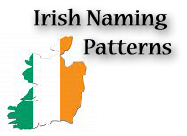
The 2nd son was usually named after the mother's father
The 3rd son was usually named after the father
The 4th son was usually named after the father's eldest brother
The 5th son was usually named after the mother's eldest brother
The 1st daughter was usually named after the mother's mother
The 2nd daughter was usually named after the father's mother
The 3rd daughter was usually named after the mother
The 4th daughter was usually named after the mother's eldest sister
The 5th daughter was usually named after the father's eldest sister |
The traditional Norwegian naming practice is
to use patronyms. If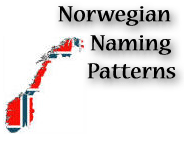 a man called Hans Andersen had a son called Anders, he would be
called Anders Hansen. A daughter named Brita would be called
Brita Hansdatter, often written Hansdtr. or Hansdt. or even Hansd. Very
often a child would get her or his first name from one of the grandparents.
But this is by far a general rule.
a man called Hans Andersen had a son called Anders, he would be
called Anders Hansen. A daughter named Brita would be called
Brita Hansdatter, often written Hansdtr. or Hansdt. or even Hansd. Very
often a child would get her or his first name from one of the grandparents.
But this is by far a general rule.
During the last decades of the 19th Century the patronym practice was
abandoned. The grandson of Ole Johannessen may call himself Ole Johannessen
in the first part of his life, because he was the son of Johannes Olsen. If
he stilled lived at the Os farm he could then start calling himself Ole Os,
abandoning the partronym and adopting the addresses as the name. The name of
the farm became a family name. If he had moved to Bergen he may start
calling himself Ole Olsen, because his father had Olsen as his last name, or
at least his son would call himself not Olsen as the last name, but
Johannessen as his father. The partronym changed into a family name. The
daughters would call themselves Johannessen, not Johannesdtr.. |
Naming after Saints
Saints and their Feast Days were very important to the Polish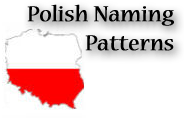 people. Many parents consulted their pastor and/or the Roman
Calendar to name their children. The parents looked for a saint
whose feast day was on or near the birth or baptismal date of their
child. The feast day was usually not more than three weeks after the birth
or baptism.
people. Many parents consulted their pastor and/or the Roman
Calendar to name their children. The parents looked for a saint
whose feast day was on or near the birth or baptismal date of their
child. The feast day was usually not more than three weeks after the birth
or baptism.
Poles did not celebrate their birthdays, as
we do now. They celebrated the feast day of the saint for whom they were
named or the anniversary of their baptism. Many families in Poland today
still observe this tradition. Note: Keep in mind that many immigrants from
Poland may have given their baptismal date or feast day instead of their
actual date of birth when providing a birth date for American records.
Naming after Godparents
Some parents named their child after one of the godparents. The custom was
not as common and varied by locality. The godfather was called a kmotr or
kumoter, and the godmother was called a kumoszka. |
The Ukrainian people began using Christian
first names about 988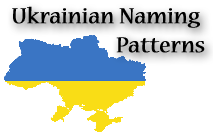 A.D., when Christianity was introduced to the Ukraine. These first names,
originally of Roman, Greek, and Hebrew origin, were modified to the
Ukrainian language. (For example, John became Ivan and Michael became
Mykhailo.) Also, many children were
given the names of Slavic or Ukrainian saints, many of them known only in
Eastern Europe.
A.D., when Christianity was introduced to the Ukraine. These first names,
originally of Roman, Greek, and Hebrew origin, were modified to the
Ukrainian language. (For example, John became Ivan and Michael became
Mykhailo.) Also, many children were
given the names of Slavic or Ukrainian saints, many of them known only in
Eastern Europe.
Children were named within eight days of
birth. The name was often selected by the priest and not the parents.
Sometimes the parents suggested a name which the priest then approved. The
child's name was the name of the patron saint on whose feast day the child
was born or baptized, or the name of a patron saint whose feast day fell
within seven days after the child's birth. The godparents took the infant
to the church. The parents were usually not present for the baptism.
Often, the parents did not learn the chosen name of their child until the
baby was returned home by the godparents.
In Ukrainian custom, names were chosen
based on the church calendar, the Byzantine Calendar. This calendar, which
starts with September, contains many different saints' names than the Roman
Calendar. The dates of some feast days differ between the two calendars.
Many girls were given a female version of the name of a male saint by adding
an "a" to the end of the name. |
|